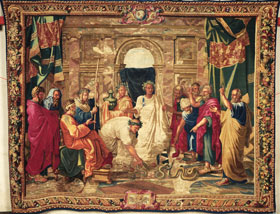Moses changing Aaron’s rod into a serpent: tapestry and painting

La verge changée en serpent
collection du Mobilier national
© I.Bideau
You are now in front of the tapestry called Moses changing Aaron’s rod into a serpent. It was made at the Gobelins tapestry works in the workshop of Jean Lefebvre in 1685. It was woven on a high-warp loom, from wool and silk with gold thread. It is modelled on the painting exhibited to your left: an oil on canvas by Nicolas Poussin, painted after 1645 and normally housed in the Louvre.
In this passage from the Book of Exodus, Moses wishes to convince Pharaoh to allow his people to leave Egypt. To prove that this request comes from God, he changes his brother Aaron’s rod into a serpent in front of Pharaoh and his priests. These manage to do the same thing by a trick of sorcery, but their serpents are immediately devoured by the serpent of Moses.
In Poussin’s painting, on your left, the confrontation between divine power and pagan beliefs is expressed visually by a clear and rigorous symmetrical composition.
Pharaoh is on the left, seated on a throne and surrounded by his court. In the centre, the snakes of the priests are being devoured by Moses’ serpent. On the right, facing Pharaoh, Moses and Aaron are pointing at the snakes and also lifting a finger to heaven, to explain that this is the work of God.
The gestures and facial expressions are extremely clear, conveying the surprise or indignation of the sorcerers, and the assurance of Moses and Aaron. This work also shows a pronounced taste for historical reconstruction: the large stick held by one of the priests is for example a Tau with an Egyptian black and white ibis on top. In a curious mixture, the imposing architecture of the background, the furniture and clothing are on the other hand of Greek and Roman inspiration.
